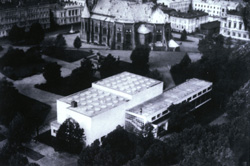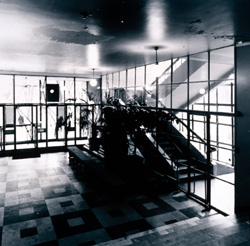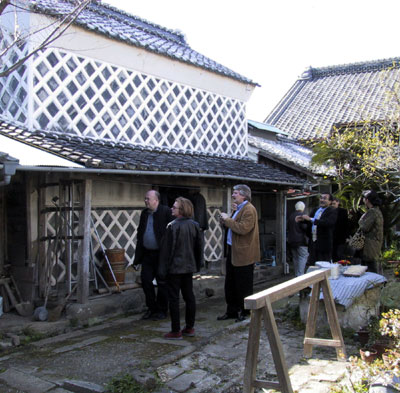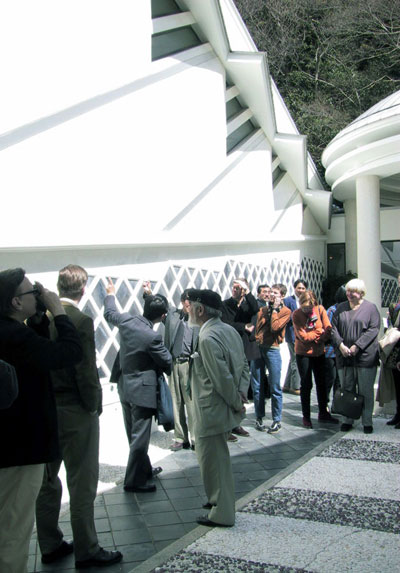
| ||||
Presentation
|
|
|
 It is my intention to present a key work of Alvar Aalto's, the Library in Viipuri (now part of Russia) from the standpoint of its design and history, at once cultural and architectural, and its influence on the life of Viipuri's inhabitants. It is my intention to present a key work of Alvar Aalto's, the Library in Viipuri (now part of Russia) from the standpoint of its design and history, at once cultural and architectural, and its influence on the life of Viipuri's inhabitants.
Alvar Aalto, surely Finland's best known architect, spent several years designing Viipuri's main library. His "WWW" entry won first place in the open architectural competition of 1927 and he continued to develop it on the lines of a classical form language until a global economic downturn intervened. Aalto's architectonic form language underwent a total transformation in the process. Although in the library building finally completed at the start of the 1930s certain functional congruities with the 1920 plans can be perceived, it is in fact a different building from that which won the competition. The buildingユs location was also moved several hundred meters, although it still remained within the central axis of the city's park.
Viipuri library in the 30's, before the war
 Viipuri City Library was completed in 1935 and represented at the time the most progressive library design in the world. It is regarded as one of the key works of Aalto's architecture and the building immediately graced the covers of the British Architectural Review and the Italian Casabella. The building of Viipuri Library strengthened Alvar Aalto's international renown as being one of the world'vs leading architects. The library is designed with extreme care, contains several novel design principles for its day and its details are wrought in a manner that is technically superior (a thing characteristic of Aalto's architecture in general). The building quickly turned into a living room for the inhabitants of Viipuri while its modern, not to say radical, architecture provoked ambivalent feelings. Viipuri City Library was completed in 1935 and represented at the time the most progressive library design in the world. It is regarded as one of the key works of Aalto's architecture and the building immediately graced the covers of the British Architectural Review and the Italian Casabella. The building of Viipuri Library strengthened Alvar Aalto's international renown as being one of the world'vs leading architects. The library is designed with extreme care, contains several novel design principles for its day and its details are wrought in a manner that is technically superior (a thing characteristic of Aalto's architecture in general). The building quickly turned into a living room for the inhabitants of Viipuri while its modern, not to say radical, architecture provoked ambivalent feelings.
interior during the war years
 The activities and history of the building changed dramatically during World War II - the building only remained under the control of the Finnish inhabitants of Viipuri a mere four years before the Soviet Union invaded the city during the so-called Winter War of 1939. The city was again in Finnish hands during the second phase of the war (1941-44), people returned to their homes and the almost intact library was reopened. At the war's end, Viipuri (and a large part of eastern Finland's Karelia province) remained under Soviet control, would-be Finnish residents were evacuated to Finland and, in accordance with the Soviet internal policy of the time, people were relocated to the ceded area who had little or nothing in common with its history. The role of Aalto's library in the life of Viipuriユs inhabitants ended after another seven years or so but contemporaries still recall the architectonic richness of the experience of walking from the main entrance to the lending section. The activities and history of the building changed dramatically during World War II - the building only remained under the control of the Finnish inhabitants of Viipuri a mere four years before the Soviet Union invaded the city during the so-called Winter War of 1939. The city was again in Finnish hands during the second phase of the war (1941-44), people returned to their homes and the almost intact library was reopened. At the war's end, Viipuri (and a large part of eastern Finland's Karelia province) remained under Soviet control, would-be Finnish residents were evacuated to Finland and, in accordance with the Soviet internal policy of the time, people were relocated to the ceded area who had little or nothing in common with its history. The role of Aalto's library in the life of Viipuriユs inhabitants ended after another seven years or so but contemporaries still recall the architectonic richness of the experience of walking from the main entrance to the lending section.
view of the main lobby in the beginning of the 90's
(Photo: Vijnanda Derco)  After the war, the building was allowed to fall into disrepair: the ceiling panels were used for firewood and vagrants lived in the building. In the mid 1950's (after Stalinist style renovation plans were rejected), it was refurbished to look more or less like it did earlier. It was again used as the city library and today it is the main cultural gathering point for the city's inhabitants. Alvar Aalto had no hand in the renovation. In his view, it was as if the library no longer existed and, indeed, it is described in Sigfried Giedion's History of Architecture textbook as having been destroyed in the war! After the war, the building was allowed to fall into disrepair: the ceiling panels were used for firewood and vagrants lived in the building. In the mid 1950's (after Stalinist style renovation plans were rejected), it was refurbished to look more or less like it did earlier. It was again used as the city library and today it is the main cultural gathering point for the city's inhabitants. Alvar Aalto had no hand in the renovation. In his view, it was as if the library no longer existed and, indeed, it is described in Sigfried Giedion's History of Architecture textbook as having been destroyed in the war!
The library became very decrepit over the years and following Aalto's death in 1976 and especially the breakup of the Soviet Union in 1991, it has been the object of an international refurbishment operation, managed from Finland. Little by little, the facade and roof of the building have been restored to their original state but there is still much to be done before Viipuri library regains its pre-War splendor. What lesson can we learn from the tale of this individual building and how is what I speak of connected to the problems we meet everywhere in the western world - to the flight from the land towards new growth centres? In my opinion, it is essential to realize that a building designed with care and professional skill can last through thick and thin - two completely different societies, two wars (Finland's Winter War and the Continuation War) and careless use - as long as its underlying purpose is universal: books are read and lent in Viipuri today in exactly the same fashion as they were seventy years ago. The buildings internal functions, children's section included, are still used in the same way as in the 1930's and the office areas and storage spaces operate as they did originally.  The tale of Viipuri library is a source of enlightenment in planning the future of the Matzuzaki area also: we must dare to make decisions of lasting import, decisions that demand courage and are meaningful for the inhabitants of a place. What is old must be cherished, existing traditions and infrastructure must be upheld and novel, "Disneyland" style solutions, which may belong to the times but not to the place, avoided. We must make decisions in support of the local way of life, its landscape, history, culture and cityscape, and particularly important when designing buildings, it pays to employ the best possible professional skill. In this way, we will give wings to development and ensure a lasting future. The tale of Viipuri library is a source of enlightenment in planning the future of the Matzuzaki area also: we must dare to make decisions of lasting import, decisions that demand courage and are meaningful for the inhabitants of a place. What is old must be cherished, existing traditions and infrastructure must be upheld and novel, "Disneyland" style solutions, which may belong to the times but not to the place, avoided. We must make decisions in support of the local way of life, its landscape, history, culture and cityscape, and particularly important when designing buildings, it pays to employ the best possible professional skill. In this way, we will give wings to development and ensure a lasting future.

visit a traditional town house and The Chohachi Museum, Matsuzaki-cho Japan Finland Design Association (Japan) c/o The Finnish Institute in Japan 3-5-39 Minami Azabu, Minato-ku, Tokyo, Japan 106-8561 c/o GK Graphics Incorporated telephone : 03-5952-6831 facsimile : 03-5952-6832 e-mail : jfda@gk-design.co.jp previous | ||